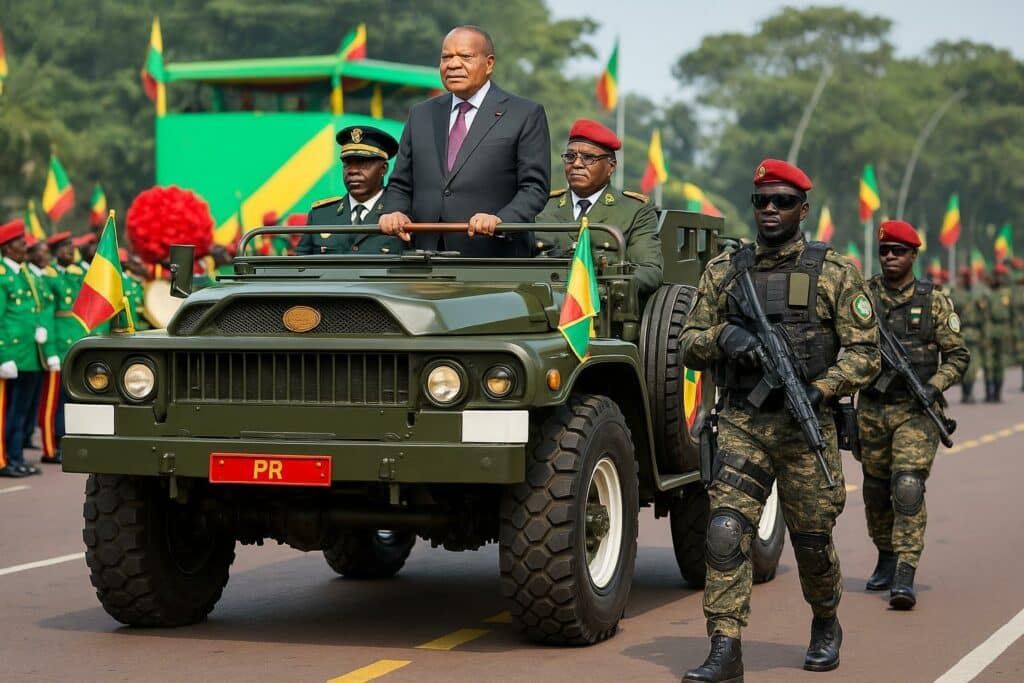A Boulevard Reborn for a Milestone Celebration
Shortly after ten o’clock on 15 August 2025, Brazzaville’s recently refurbished General Alfred Raoul Boulevard offered a striking stage for the Republic of the Congo’s 65th anniversary of independence. President Denis Sassou Nguesso, accompanied by First Lady Antoinette Sassou Nguesso, presided over the ceremonies before a grandstand that brought together leaders of all constitutional institutions, the diplomatic corps and an unusually large civilian audience. According to local daily Les Dépêches de Brazzaville, the renovation of the boulevard had been fast-tracked to emphasise “the capital’s new face” ahead of the festivities (Les Dépêches de Brazzaville, 14 August 2025).
The official theme, “Mobilised in Peace, Together Pursuing the Path to Development”, permeated the day’s symbolism. Government communicators stressed continuity with the 2024 National Development Plan, framing the parade as both a celebration and a progress report on infrastructure, security and regional cooperation (Ministry of Communication press briefing, 13 August 2025).
Diplomatic Overtones and Soft-Power Signals
One of the most commented-upon details was the participation of a detachment from the United States Air Forces in Europe and Africa band. For Washington, the performance formed part of an ongoing cultural diplomacy programme across the Gulf of Guinea; for Brazzaville, it served as evidence of diversified partnerships beyond traditional Francophone channels. A spokesperson at the U.S. Embassy described the gesture as “music in service of mutual security interests” (U.S. Embassy Brazzaville media note, 15 August 2025).
Regional observers noted that the President’s salute to the foreign musicians, broadcast live on Télé Congo, subtly complemented recent high-level exchanges with partners from the European Union, China and the African Union. The choice of a musical, rather than purely martial, contribution avoided any perception of external military tutelage while reinforcing Congo’s image as a stable interlocutor in Central Africa.
Martial Precision and Modernisation Narrative
The parade unfolded in four segments—infantry columns, motorised units, air assets and civilian contingents—lasting two hours and thirty minutes by the master of ceremony’s chronometer. Gen. Guy Blanchard Okoï, Chief of the General Staff, accompanied the Head of State during the troop review, while Brig. Gen. Fermeté Blanchard Nguinou orchestrated the marching order.
Seasoned analysts of Central African security underscored the appearance of upgraded MI-35P attack helicopters and an Ilyushin-76 strategic airlifter—platforms that illustrate the Armed Forces of Congo’s gradual modernisation drive. Defence attachés interviewed by the pan-African magazine Continental Defence argued that the visible readiness of these assets seeks to deter transnational threats spilling over from neighbouring conflict zones, notably in the eastern Democratic Republic of the Congo (Continental Defence, September 2025 edition).
Civic Mosaic and Cultural Resonance
If the military hardware captured attention, the civilian segment offered an equally potent tableau of national cohesion. Representatives of youth associations, trade unions and the Kimbanguist Church marched to the cadence of brass bands, projecting an inter-generational consensus around independence ideals. Sociologist Esdras Ngampika of Marien Ngouabi University remarked that the inclusion of faith-based groups reflects “a deliberate strategy to align spiritual and republican values without sacrificing secular principles” (Radio Congo interview, 16 August 2025).
The dense spectatorship—municipal authorities estimated more than 30,000 people lining the boulevard—contrasted with the restrained gatherings during the pandemic years. Public enthusiasm, however, remained orderly, a detail highlighted by the prefect of Brazzaville as proof of effective policing reforms launched in 2023.
Decorations that Anchor Collective Memory
Twelve citizens were invested into various national orders of merit, among them Colonel Félix Mouzabakani, recognised as the first Chief of Staff of the Congolese Armed Forces. The honours list, vetted by the Grand Chancellery, spanned military, medical and educational service, underscoring the administration’s effort to depict nation-building as a multi-sectoral endeavour.
Political scientist Mireille Matsouani, writing in the review Afrique Stratégies, observed that such decorations serve a dual function: rewarding individual careers and cementing a historical continuum that links today’s governance to the 1960 independence generation. In her words, “decorations translate abstract patriotism into personal narratives that citizens can emulate”.
Strategic Takeaways for Domestic and Foreign Audiences
Beyond the ceremonial sheen, the 65th anniversary provided a communicative platform for Brazzaville’s strategic messaging. Domestically, it reinforced the promise of security and socio-economic advancement presented in the 2025 budgetary blueprint; internationally, it signalled Congo’s capacity to host high-visibility events without incident, a point likely to weigh in negotiations over prospective infrastructure loans and energy partnerships.
Several ambassadors present—among them those of France, China and Angola—conveyed congratulatory notes emphasising Congo’s role in sub-regional stability. Analysts at the Institute for Security Studies suggest that the meticulously executed parade may also strengthen Brazzaville’s bid for a non-permanent seat on the UN Security Council in the 2027–2028 cycle, a diplomatic objective quietly gaining momentum since late 2024.
As evening fell over the Congo River, commentators on national radio summarised the day in terms President Sassou Nguesso himself had used during his brief closing remarks: peace safeguarded, development pursued. For a nation that has experienced its share of turbulence, the formula remains both an aspiration and, judging by the choreography witnessed on 15 August, a carefully curated public narrative.

